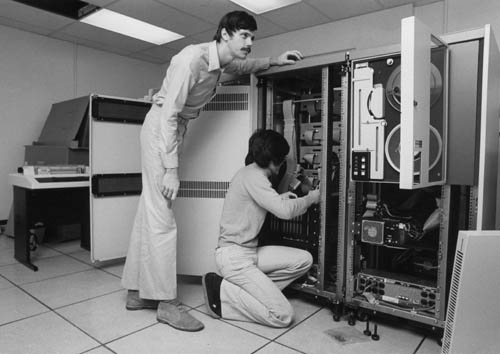
You probably have more computing power now in your cellphone than the entire campus had when Peter Jaspers-Fayer began working at U of G.
“The University had just one computer. This ‘mainframe’ was so big that it would have taken up half of the current OVC cafeteria,” he recalls.
Air-conditioning in the computer room was cranked up high to protect the sensitive machinery, and when he would come in at 3 a.m. to do maintenance (with no back-up computers to take over, all maintenance had to be done in the middle of the night) he’d wear a winter coat while he worked on the mainframe computer.
He’s glad that he’s no longer on call in the middle of the night, but after 34 years providing computer support at U of G, he still enjoys his work. “I like helping people so they can concentrate on their research and teaching. When you can save someone time and frustration and help them do their work, that’s very satisfying. I like being able to solve problems that other people can’t by using the skills I’ve developed over the years.”
Today his job is “answering questions and fixing things” for Ontario Veterinary College (OVC) staff and faculty who are having problems with their work computers. “I’m an old-school generalist,” Jaspers-Fayer adds. “I can do a little programming and a lot of trouble-shooting. People often bring me old data that’s in programs we no longer use because I know many of the old programs.”
The biggest challenge he faces is the constantly-accelerating pace of change in the computer field. “I need to keep ahead of the users,” he says. “Students will come in to see me with a project and I’ll say ‘computers can do that now?’” The University is always bringing in new programs and systems, such as the recently installed programs for keeping medical records at the veterinary clinics.
Because he wants people to be able to focus on their work, he encourages them to contact the IT department quickly when they have problems: “People sometimes sweat for hours over something I can fix in much less time.”
Jaspers-Fayer today is part of an IT team, but he remembers all too well the days when few people had the skills to keep the computers running. “I’m no longer indispensable, and I’m happy about that,” he says. He remembers one camping trip with his son when the two of them went for a hike and returned to find a rock on their picnic table, holding down a note that said “Emergency: call work immediately.”
There were other emergencies as well. “Back in the days when computers read stacks of cards to run the programs, the huge card reader was down the hall from my office. That machine was worth thousands. I was in my office one day when a student came in and asked: ‘Is it okay if smoke is coming out of the reader?’ I ran down the hall, and the room was full of blue smoke.”
The rules said the device had to be carefully shut down, but Jaspers-Fayer yanked out the power cord anyway and called the IBM service rep, who plugged the machine back in. It ran just fine.
The problem? A tiny piece of one of the cards had fallen onto the electric eye, causing the mechanism to run continually, burning the rubber roller that was supposed to push the cards forward. Easily fixed, but Jaspers-Fayer still remembers the moment of panic when he thought that expensive machine might be about to go up in flames.
He started his work career when he was an undergrad, working as a research assistant for a professor in botany. Computers were in their infancy, and part of his student job was to rewrite a “predator-prey” simulation program on those cards to be fed into the computer’s card reader. He turned out to have a knack for that kind of work and was hired by a series of professors working on projects that needed some computer help. “I hopped around from one professor and department to another,” he says. “In fact, my paycheque tended to lag one or two departments behind me, and every week I’d have to go and find it.”
At one point, there was a gap in research projects, and he worked for a machine shop in Guelph for three months. Then another professor called and he came back to the University. “My co-workers at the machine shop just shook their heads because I would be making much less money at the University,” he says. “But that shop is closed down now, and I’m still here.”
In 1976, he was hired by the computing services department. He learned a number of computer languages for programming and remembers the excitement when the new Digital Equipment Corporation’s VAX mini-computer arrived – a computer that had screens and keyboards rather than stacks of cards and paper printouts. “This computer was about the size of two large refrigerators bolted together, with disk drives as large as washing machines, but was smaller than IBM’s mainframe. It could run 32 workstations at once, all connected by RS-232 cables,” Jaspers-Fayer recalls.

Then came the early microcomputers that could sit on top of a desk. At first, programs were still contained on floppy disks that had to be inserted in the computer to do any work, but eventually a hard drive small enough for a desktop computer was invented.
“The hard drives died a lot in the beginning, and the only possible backup was to floppy disks, laboriously inserted one at time; so people didn’t do them often. Sadly, even though backups today can easily be done to external devices, people still neglect to do them,” he says with a knowing look. “Sometimes they regret it.”